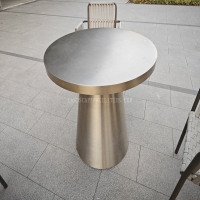Welcome to the website for landscape facilities products and knowledge.
How does the table’s design address potential issues with chemical reactions between materials?
In laboratory and industrial settings, the prevention of chemical reactions between materials is paramount for safety, accuracy, and longevity of equipment. Modern table designs address this critical concern through multiple sophisticated engineering approaches that create chemically inert and safe working environments.
The foundation of chemical reaction prevention begins with material selection. Manufacturers specifically choose non-reactive materials that demonstrate high resistance to corrosive substances. Stainless steel, particularly grades 316 and 304, offers excellent corrosion resistance against most chemicals. For applications involving strong acids or bases, specialized polymers like polypropylene or PVDF (polyvinylidene fluoride) provide superior chemical inertness. These materials are engineered to withstand exposure to harsh substances without degrading or participating in unwanted chemical reactions.
Surface treatment technologies represent another crucial layer of protection. Advanced coating systems create barrier layers that physically separate the table surface from potentially reactive substances. Epoxy resin coatings, for instance, form seamless, non-porous surfaces that prevent chemical penetration. Ceramic-based coatings offer exceptional thermal and chemical stability, while powder-coated finishes provide durable protection against corrosion and chemical attack. These treatments are specifically formulated to resist staining, etching, and degradation from chemical exposure.
Design integration focuses on eliminating potential reaction sites through seamless construction. Tables manufactured with coved corners and integrated sinks prevent chemical pooling and accumulation in joints where reactions could initiate. Smooth, non-porous surfaces without cracks or crevices minimize areas where chemicals could become trapped and react over time. This seamless approach extends to edge banding and connection points, ensuring no exposed substrates that might react with spilled chemicals.
The engineering extends to structural components where material compatibility is carefully considered. Fasteners, supports, and adjustment mechanisms are manufactured from materials compatible with the table surface to prevent galvanic corrosion. When different metals must be used, isolation techniques such as plastic washers or coating systems prevent direct metal-to-metal contact that could initiate electrochemical reactions.
For specialized applications, manufacturers incorporate secondary containment systems and chemical-resistant seals. These features provide additional protection against accidental spills and prevent chemical migration to vulnerable areas. The integration of chemical-resistant gaskets and seals around fixtures and connections creates multiple barriers against potential reaction scenarios.
Advanced manufacturing techniques ensure consistent material properties throughout the table structure. Injection molding, continuous welding, and controlled curing processes create homogeneous surfaces without weak points where chemical reactions could begin. Quality control measures verify chemical resistance through standardized testing protocols that simulate long-term chemical exposure.
The result is a comprehensive engineering solution that addresses chemical compatibility at every level – from molecular material properties to macroscopic design features. These tables are not merely passive surfaces but actively prevent chemical reactions through carefully selected materials, protective treatments, and intelligent design that anticipates and mitigates potential reaction pathways. This multi-layered approach ensures laboratory safety, protects experiments from contamination, and extends equipment lifespan in chemically challenging environments.
Related search:

Recommendation
Outdoor Metal Table - Classic Outdoor Furniture, Stainless Steel Table, Durable and Reliable